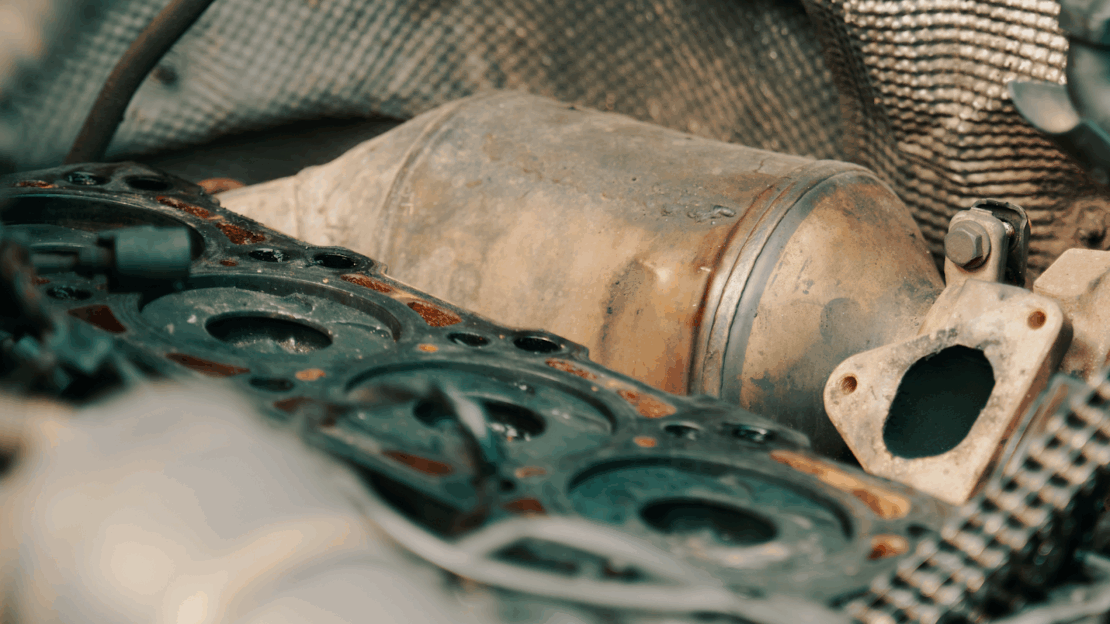Understanding Your Bus’s DPF System
If your bus is showing warning lights, losing power, or emitting black smoke, it may be time to take a closer look at its exhaust system, specifically the Diesel Particulate Filter (DPF). Modern diesel buses are equipped with advanced emissions technology to reduce pollution, keep fleets compliant, and maintain engine efficiency.
At the heart of this system is the DPF, a critical component that often goes unnoticed until performance issues arise.

What is a Diesel Particulate Filter (DPF)?
A Diesel Particulate Filter (DPF) is part of your bus’s exhaust and emissions system. It traps soot and ash from diesel engine exhaust to prevent harmful emissions and help your bus pass inspections. Most DPFs remove 85% or more of soot particles, keeping them compliant with EPA emissions standards.
While soot can be burned off through regeneration, ash is incombustible and accumulates over time, making professional cleaning essential for maintaining filter efficiency and engine performance.
How Does a DPF Work?
The DPF captures and removes soot and particulate matter from diesel exhaust through a ceramic honeycomb structure. Over time, the trapped soot must be burned off in a process called regeneration, which converts soot into ash.
Types of DPF Regeneration
According to the Universal Technical Institute (UTI), there are three main ways a DPF regenerates:
- Passive regeneration: Happens automatically during highway driving when engine exhaust is hot enough.
- Active regeneration: Triggered when the engine isn’t producing enough heat. Fuel is injected to increase temperature and burn off soot.
- Parked/manual regeneration: Required if passive and active regeneration fail. The bus must be stationary, and the process can take 20–60 minutes. For safety, exhaust must be directed away from flammable materials.
Even with proper regeneration, ash accumulation cannot be burned off and can eventually reduce filter efficiency, increase exhaust backpressure, and slightly raise fuel consumption over time. Studies show that after 33,000 miles, ash may equal soot in the filter, and after 150,000 miles, ash can comprise up to 80% of the trapped material.
Common Signs Your Bus Needs DPF Service
Fleet managers or drivers should look out for:
- Orange engine warning light or DPF indicator on the dashboard
- Reduced engine performance or sluggish acceleration
- Black smoke coming from the exhaust
- Higher fuel consumption than usual
- Frequent active regeneration cycles
If your bus shows any of these symptoms, it’s time to schedule professional diesel exhaust service to avoid costly repairs.
Causes of a Blocked or Failing DPF
Several factors can lead to a blocked or failing DPF:
- Short trips or stop-and-go driving: Prevents the filter from fully regenerating.
- Poor servicing or maintenance: Skipping routine checks accelerates wear.
- Incorrect oil or low-quality fuel: Must use low-ash oil and ultra-low sulfur diesel (ULSD) to prevent excessive soot.
- Frequent low-fuel operation: Increases the likelihood of clogging.
- Extended use leading to ash accumulation, primarily from engine oil additives, fuel impurities, and normal engine wear
Addressing these factors proactively helps extend the life of your bus’s exhaust system and DPF.
The Cost of Neglecting DPF Maintenance
Replacing a diesel particulate filter can cost $3,000 to $10,000, depending on the vehicle. For older buses, that may be more than the value of the vehicle itself. Regular professional cleaning is a far more affordable option and extends the filter’s life significantly.
The Professional DPF Cleaning Process
At DeVivo Bus Sales, we use industry-approved cleaning methods that restore filters to near-new condition:
- High-temperature baking to loosen hardened soot and ash deposits.
- Compressed air cleaning by trained technicians to avoid damaging the fragile ceramic structure.
- Reverse flow machine cleaning with high-pressure air to fully clear filter channels.
Manual or targeted cleaning is particularly effective because ash tends to accumulate in certain areas of the filter that automated systems may miss. This process typically takes about 90 minutes and helps prevent unexpected downtime.
How Often Should You Clean a DPF?
- First cleaning: 150,000 to 200,000 miles
- After that: Every 100,000 miles
- Best practice for fleets: Incorporate DPF cleaning into routine fleet maintenance programs instead of waiting for the warning light
Regular cleaning ensures that both soot and ash are properly removed, preventing engine strain, maintaining fuel efficiency, and extending filter life.
Why Choose Professional DPF Service for Your Bus Fleet
- Prevents costly repairs or replacements
- Keeps fleets compliant with emissions standards
- Reduces downtime by avoiding unexpected breakdowns
- Local service from experienced technicians at one of our locations
Schedule Your Bus DPF Cleaning Today
Don’t wait until your DPF warning light comes on. Stay ahead of costly issues with professional bus DPF cleaning service from DeVivo Bus Sales.
Contact our service team today to schedule DPF maintenance and keep your buses running clean, compliant, and efficient.
FAQ
Q: How can I tell if my bus DPF is blocked or failing?
A: Look for an orange DPF or engine warning light, reduced power, black smoke, or increased fuel consumption. Early detection prevents costly repairs.
Q: How often should a bus DPF be professionally cleaned?
A: First cleaning is typically recommended around 150,000–200,000 miles, then every 100,000 miles. Proactive maintenance keeps buses running efficiently.
Q: What causes a DPF to become blocked or fail?
A: Short trips, stop-and-go driving, poor servicing, using incorrect oil or low-quality fuel, running the bus frequently on low fuel, and ash accumulation from normal engine use can all lead to DPF issues.